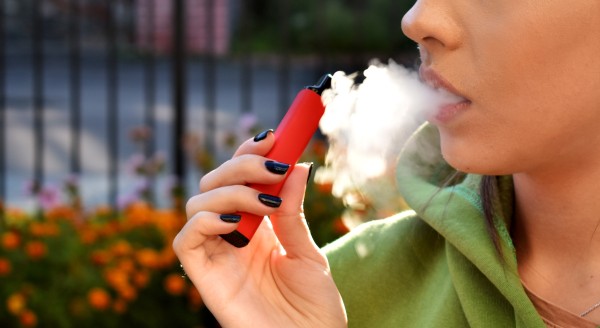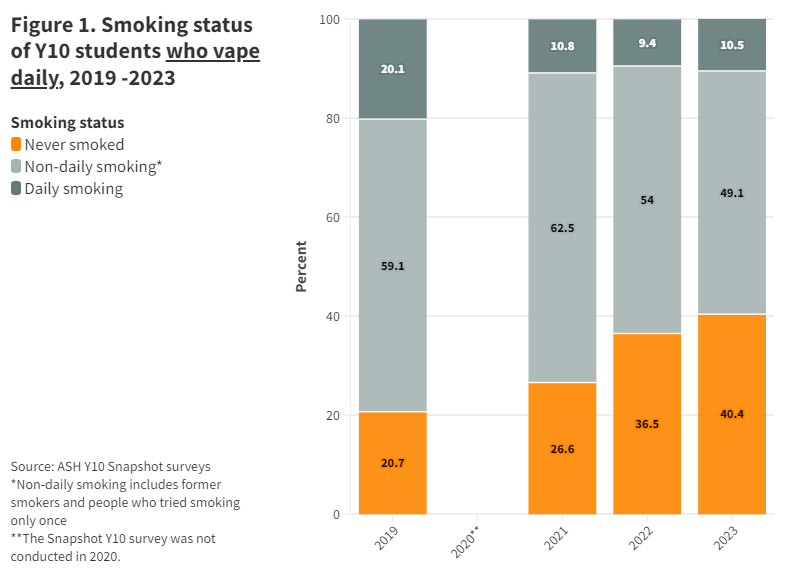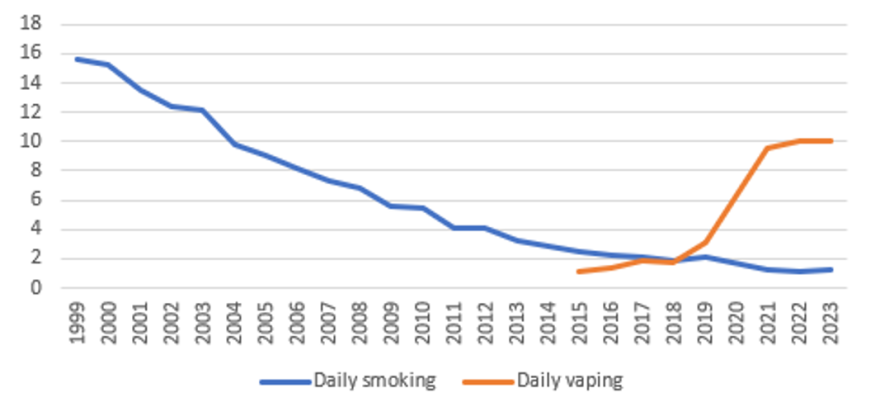Summary
Many groups have raised concerns about rising youth vaping rates, particularly among young people who had never previously smoked. Evidence from schools and parents supports these concerns, as do survey findings. In this Briefing, we examine new data from the ASH Year 10 Snapshot survey and explore trends in smoking among young people who vape. We find the proportion of young people that vape daily and that have never smoked doubled between 2019 and 2023. These results suggest vaping is not displacing smoking, which was already low among Y10 students, but is recruiting new nicotine users. The findings indicate an urgent need for stronger policies that protect young people from both vaping and smoking.
Vaping’s role in fostering population wellbeing remains disputed particularly given rising youth vaping. Manatū Hauora, the Ministry of Health, accepts vaping offers a reduced harm alternative to smoking and suggests people unable to quit smoking adopt vaping. However, a regulatory loophole saw widespread and aggressive marketing of nicotine vaping products to young people, most of whom do not smoke, while few campaigns targeted older people, who often struggle to quit smoking and represent a smaller market. Positioned as a fashionable lifestyle accessory that facilitates social connections, very cheap, disposable, nicotine-salt products increased the affordability, appeal, convenience of vaping to young people.1-4
Not surprisingly, youth vaping rose rapidly; the ASH Year 10 survey reported that 10% of 14-15 year olds vape daily (22% among Māori) and the latest NZ Health survey found 15% of young people aged 15 to 17 vape daily (20% reported at least monthly vaping), as do 25% of 18-24 year olds (30% vape at least monthly).
We have previously raised concerns about youth vaping (see here, here and here) and explained why current and proposed regulations would not sufficiently protect young people from vaping (see here, here, here, here and here, for example). Schools, parents, and Māori leaders have made similar points. However, others have suggested concerns over youth vaping have prompted “panic” and unhelpful responses, and argued that much youth vaping is experimental and does not represent dependence.
An increasing proportion of young daily vapers have never smoked
The ASH Year 10 survey reports present prevalence of vaping among adolescents who have never smoked (4.6% vaped daily in 2023) and compares it to vaping among adolescents who smoke daily (87.5% vaped daily in 2023). However, this comparison downplays daily vaping among never smokers, who make up the vast majority of this age group and account for a substantial proportion of young people who report vaping daily (explained further in the Appendix below).
We explored smoking status among those who vape daily by calculating the proportion of young people that vape each day and that had never smoked, smoked less than daily (including former and current experimental smokers) and the proportion who both vape and smoke daily (i.e. dual users) based on ASH Year 10 data from 2019, 2021, 2022 and 2023.
This approach is important as the sub-groups of young people who have never smoked and those who smoke every day are vastly different in size. Ministry of Education school rolls data for 2023 and estimates from the 2023 Snapshot Y10 survey, show that 58,694 of Y10 students have never smoked (i.e., 87.8% of the 66,850 Y10 students) while 802 Y10 students smoke each day (i.e., 1.2% of Y10 students). Even if only a small proportion of the 58,694 students who have never smoked vape daily, the actual number of students involved would be large. Conversely, even a large proportion of a small sub-group, such as the 802 students who smoke each day, would amount to relatively few people (see Appendix, Figure A2). Figure 1 presents our analyses.
Figure 1 shows that in 2019, around 20% of Y10 students reporting daily vaping had never smoked while 20% smoked daily (the remaining 60% represent young people who may only have had a puff on a cigarette once in the past through to those who smoke regularly, but not every day). From 2021 onwards, the proportion of daily vapers that had never smoked increased steadily and reached 40% in 2023, a doubling over four years. By contrast, the proportion of daily vapers that reported smoking each day decreased to around 10% and halved over the four years examined. The proportion of daily vapers who did not smoke daily (and may only have puffed on a cigarette once) declined from over 60% in 2021 to under 50% in 2023, but remains high. A recent analysis of NZHS survey data by the Ministry of Health reported similar findings for 15-17 year olds; analyses of pooled data from the 2020/21 and 2021/22 surveys found that 76% of daily vapers had never smoked, 18% formerly smoked, and only 6% currently smoked.
What do these findings mean?
First, these data indicate that many young people who have never smoked vape daily, a finding also reported in the Youth19 study, which examined the smoking status of young people who vape.5 Furthermore, these findings suggest that vaping is not displacing smoking, which was already low among Y10 students, but is recruiting new nicotine users. The Year 10 survey data support this conclusion; nearly all of the recent steep decline in adolescent daily smoking prevalence (from 15% in 2000 to 3% in 2013) occurred before e-cigarette use was prevalent (1% daily use in 2015 the first year it was measured). Daily e-cigarette use is now at levels not seen for daily smoking since 2004 (see Appendix, Figure A3).
Second, daily vaping typically indicates nicotine dependence and addiction. Young people who vape daily often report intense physical cravings, and recount how vaping dominates their thoughts and disrupts their school work or paid employment.6 This addiction can disrupt young people’s identity, relationships, academic and sporting achievements, and overall wellbeing.7
How should the Government respond?
Evidence vaping prevalence has risen among young people who have never smoked, who now represent 40% of daily vapers, suggests stronger policies on vaping are required, alongside more rigorous enforcement of existing laws.
We have previously suggested reducing the availability of vaping products by restricting the sale of these to specialist vape stores whose staff have training in smoking cessation (pharmacies offer another option). We also recommended more comprehensive proximity and density limits on vape stores, disallowing all disposable vapes, reducing vaping’s visibility by no longer permitting window or in-store displays, or product promotions such as competitions, loyalty programmes and price discounts (e.g. ‘buy one, get one free’ type deals). Finally, we suggested mandating generic (black and white) packaging, and strengthening the age verification processes used by stores and online retailers.
Furthermore, implementing all measures in existing smokefree legislation rather than repealing this statute, is a vital complement to introducing restrictions on vaping. Measures such as de-nicotinising tobacco and reducing its availability will greatly reduce the risk that vaping restrictions inadvertently result in young people switching from vaping to smoking.
New policies currently being introduced set out some proximity limits, restrict some disposable vapes, and limit nicotine content. Just as past policies designed to reduce youth vaping proved ineffective, we do not believe the current measures will be sufficient to provide the protection young people deserve.
Prime Minister Luxon has indicated he plans to go “back to the drawing board” when regulating vaping. We hope his plans will reflect the coalition government’s commitment to making “decisions … based on data and evidence”, something he was apparently willing to forgo when agreeing to repeal evidence-based smokefree legislation.
What is new in this Briefing?
- The proportion of young people that report vaping daily and that have never smoked has risen considerably between 2019 and 2023.
- Commentaries that suggest only a small proportion of daily vapers have never smoked are incorrect.
- These findings support concerns raised by schools and community workers that many young people who have never smoked, or who have smoked only experimentally, are now vaping daily.
Implications for public health practice and policy
- Current measures to protect young people from vaping uptake have not reduced vaping prevalence or deterred young people who have never smoked from vaping.
- Stronger enforcement and more comprehensive measures, including reducing the availability and appeal of vaping products to young people, are needed to help reduce vaping in this age group.
- Stronger tobacco control measures, such as those the new government intends to repeal, are vital to prevent one of the major risks associated with youth vaping – that, once dependent on nicotine, young vapers will turn to tobacco smoking, particularly if tobacco products remain widely available.
Authors
Prof Janet Hoek, Co-Director of ASPIRE Aotearoa Research Centre and Department of Public Health, University of Otago Wellington
Dr Jude Ball, ASPIRE Aotearoa Research Centre and Assistant Research Fellow, Department of Public Health, University of Otago Wellington
Prof Philip Gendall, ASPIRE Aotearoa Research Centre and Senior Research Fellow, Department of Public Health, University of Otago Wellington
Acknowledgements
We thank Professors Richard Edwards and Nick Wilson for helpful comments on an earlier draft of this briefing, and Dr John Kerr for editorial advice and illustrations.
Appendix: Daily vaping prevalence by smoking status among Y10 students in Aotearoa New Zealand
Examining the prevalence of daily vaping among groups by smoking status (where the groups differ greatly in size) can be misleading. The graph below downplays daily vaping among never-smokers, who make up the vast majority of this age group and account for a substantial proportion of young people who report vaping daily.
Figure A1. Daily vaping prevalence by smoking status (2015–2023). Source: ASH Year 10 Snapshot Survey 2023
Figure A2. Daily vaping among Year 10 students by smoking status, 2023
Adolescent smoking decline predates the introduction of vapes. This graph shows that daily nicotine use has increased substantially since 2019.
Figure A3. Prevalence of daily smoking and daily vaping among Year 10 students, 1999-2023
Data and calculations for Figure 1 can be accessed here: Data and calculations spreadsheet
This article is part of the series Briefings to the Incoming Government, highlighting challenges and opportunities in the public health policy space.



